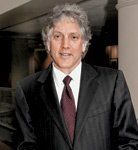What employers want: As GE's global healthcare leader, Dr. Robert Galvin measures on value
The era of rising healthcare costs created a new discipline in the business world. Large employers such as industrial giant General Electric (GE) wanted to know why healthcare costs were disproportionately eroding profits, how to spend wisely, how to design worker benefits that made sense and how to reduce waste. In the early 1990s, self-funded GE was spending $800 million annually on healthcare, so a cost reduction of just 5% would equal $40 million, or the equivalent of 800 jobs.
The era of rising healthcare costs created a new discipline in the business world. Large employers such as industrial giant General Electric (GE) wanted to know why healthcare costs were disproportionately eroding profits, how to spend wisely, how to design worker benefits that made sense and how to reduce waste. In the early 1990s, self-funded GE was spending $800 million annually on healthcare, so a cost reduction of just 5% would equal $40 million, or the equivalent of 800 jobs.

"One of the issues that self-funded employers have wrestled with over the past number of decades is if they should [resource healthcare] themselves or if they need an intermediary. If you look back even as recently as the '80s and early '90s, what you had as an intermediary was essentially big insurance companies that did healthcare as well as property, casualty and auto insurance."

Plans in perspective
Comparatively, GE spends $2.5 billion annually, while national and regional health plans spend in the tens of billions. Dr. Galvin says it doesn't make much sense for even large, self-funded employers to resource healthcare independently without the partnership of a health plan because they don't have enough purchasing power to significantly drive value in the market. He credits health plans for becoming intermediaries for companies such as GE and for their efforts to balance the needs of large employers with the needs of doctors and hospitals.
"They've not only proven themselves but have become a sustaining part-I believe a permanently sustaining part-of the system from the point of view of employers," he says. "That being said, some health plans are better than others. What we look for [as employers] is a market-based model with healthy competition around quality and cost that doesn't include avoiding sick people, where doctors and hospitals are rewarded for doing better, and which offers choice to employees based around quality and price."
He says employers like the healthy competition among plans because it leads to innovation and better aligned interests. Overall, he says, the plans' movement has been positive, and the more successful plans are the ones that view the patient as the ultimate customer. There can be "no let up on the pressure" on plans, however, because more action needs to take place to continue establishing value in healthcare.
Plans have the difficult task of answering the employers' drive to publicize quality data while addressing providers' reluctance. Being a physician himself, Dr. Galvin knows that releasing performance measurements to the public is difficult for providers, especially since the tradition of medical practice has always included quality as a tacit rule and a matter of pride, not a quantitative statistic. The bigger and more concrete hurdle is that there hasn't been a system to support measurement and reporting.
As much as employers would like plans to move quality information ahead quickly, measures also have to be fair, accurate and risk adjusted. There are two ways employers view the need for quality reporting. "The first way is in acknowledging that we don't hide things in this country," Dr. Galvin says. "Transparency is part of what commerce in this country is about."
Conversations With Perry and Friends: Paul Fronstin, Ph.D.
May 9th 2025Perry Cohen, Pharm.D., a longtime member of the Managed Healthcare Executive editorial advisory board, is host of the Conversations with Perry and Friends podcast. In this episode, his guest is Paul Fronstin, Ph.D., director of health benefits research at the Employee Benefit Research Institute.
Listen
Conversations With Perry and Friends
April 14th 2025Perry Cohen, Pharm.D., a longtime member of the Managed Healthcare Executive editorial advisory board, is host of the Conversations with Perry and Friends podcast. His guest this episode is John Baackes, the former CEO of L.A. Care Health Plan.
Listen